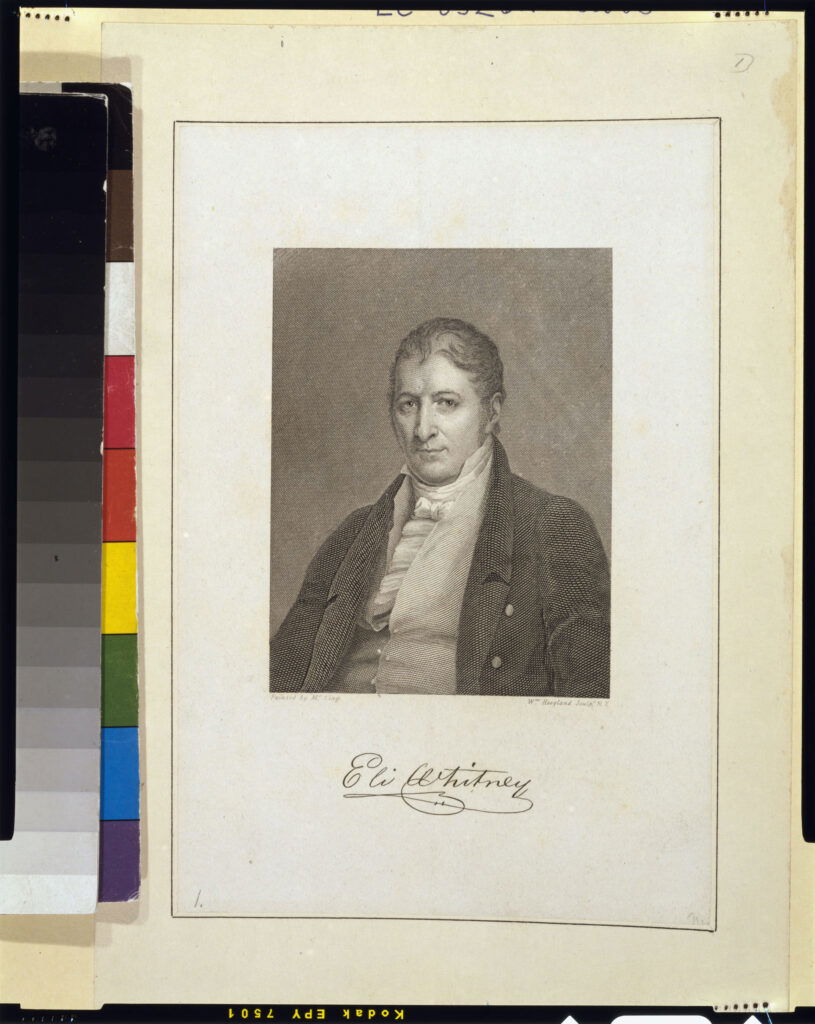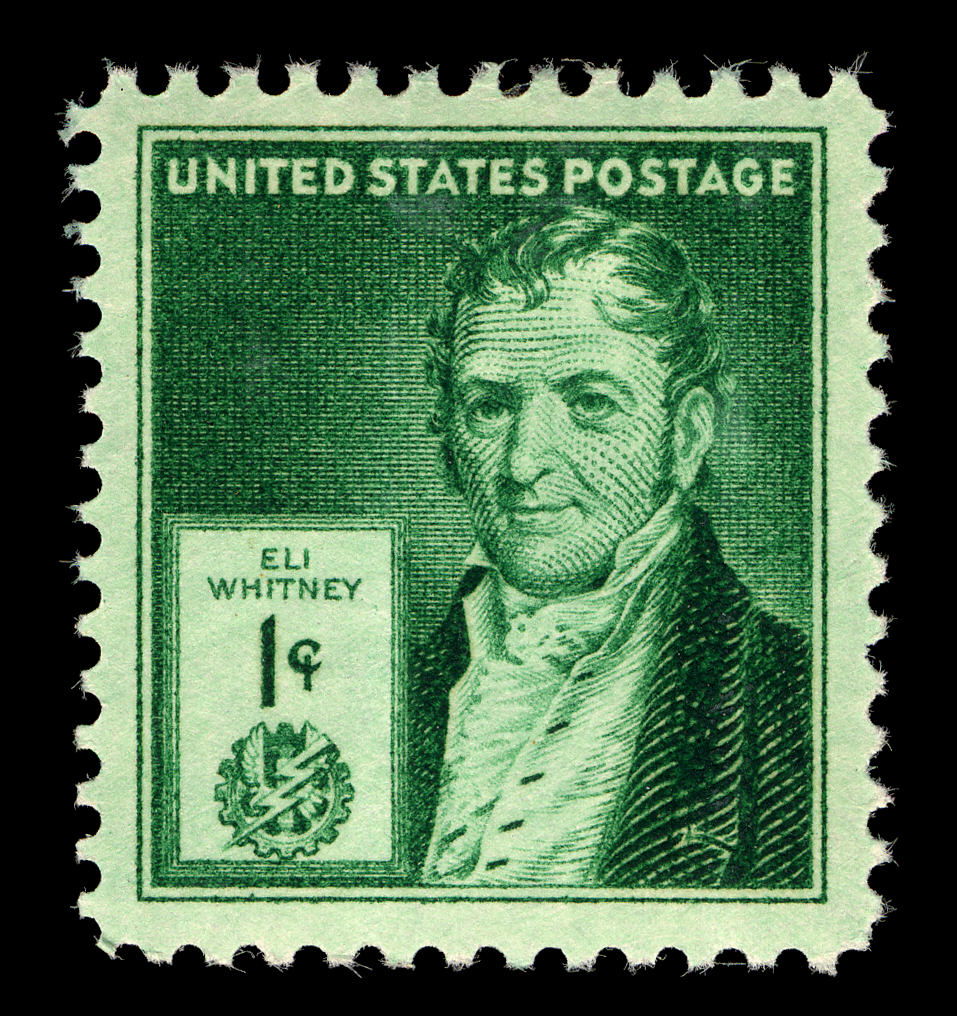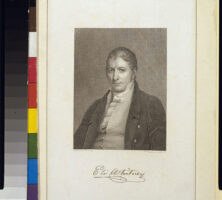Eli Whitney spent only a few months living in Georgia, but during that time, in 1793, he invented the cotton gin. Whitney’s machine expedited the extraction of seeds from upland cotton, making the crop profitable and contributing to its expansion across the South. These developments deepened the region’s commitment to enslaved laborers and ultimately placed the country on the path to the Civil War (1861-65).

Born on December 8, 1765, in Westboro, Massachusetts, Whitney was the son of a small farmer. He was raised in a household of modest means and spent his youth laboring alongside his brothers and father in the family fields. His parents observed at an early age that their son possessed unusual intellectual gifts and a curious mind. By the time he reached adolescence, Whitney had earned a local reputation as a skillful mechanic and was often approached by area farmers to help in repairing their tools and equipment.
Working for several years as a mechanic and intermittently as a tutor, Whitney earned enough money for college tuition. In 1789, at the age of twenty-four, he enrolled at Yale College (later Yale University) in New Haven, Connecticut. Following the completion of his degree in 1792, Whitney accepted a position as a tutor in the home of a wealthy South Carolina planter. Upon arriving in South Carolina, however, he learned that the position had already been filled. Hundreds of miles from home, with little money and no prospects, the young inventor had few options when he received an invitation to stay as a guest at Mulberry Grove, a plantation near Savannah owned by Catharine Greene, the widow of the famed Revolutionary War (1775-83) hero Nathanael Greene. Formerly the site of silkworm cultivation, the plantation was confiscated from Loyalist lieutenant governor John Graham and deeded to General Greene by the state of Georgia as a reward for his services during the war. Whitney accepted the invitation and agreed that he would study law while a guest in the widow’s home.
During his stay, Whitney had occasion to meet neighboring planters who would sometimes call on Catharine Greene. Over dinner one evening, two such guests discussed the region’s agricultural economy and lamented the difficulty of separating upland cotton from its seeds. Unlike Sea Island, or long staple, cotton, which had been ginned successfully for some time, the green seeds belonging to the upland, or short staple, variety clung tenaciously to the fibers, requiring separation by hand. As Whitney would later recount in a letter to his father, the planters advised him that a machine capable of efficiently cleaning cotton “would be a great thing both to the Country and to the inventor.” At Greene’s behest, he undertook to construct such a machine. Completed in only six months, Whitney’s cotton engine (or “gin”) consisted of wire teeth set in a wooden cylinder that, when rotated, separated cotton fibers from the seed. A second, smaller cylinder revolved simultaneously in the opposite direction so as to sweep the cotton fibers from the wire teeth.

Although simple in design, Whitney’s gin revolutionized the southern economy. Within only a few years, cotton replaced indigo and tobacco as the region’s major cash crop. In 1801 planters produced 48 million pounds of cotton as compared with just 2 million pounds a decade earlier. By the eve of the Civil War, the South’s cotton production exceeded a billion pounds annually.
In New England the cotton industry flourished as new mills appeared nearly overnight to keep pace with increased southern production and growing market demand for cotton textiles. Previously a luxury item available only to the wealthy, cotton fabric was now within the financial reach of ordinary farmers. But the cotton gin also resulted in the expansion of slavery in the South. Because cotton is a labor-intensive crop, the spread of cultivation deepened and broadened the region’s dependence on enslaved labor.
While southern planters would reap great profits as a result of his invention, Whitney was less fortunate. After completing his model in 1793, he returned to Connecticut to secure a patent and begin work constructing his gins for commercial use. But before he could deliver his own gins to the southern market, the region was already awash with illegal replications of his design. If Whitney were to profit by his invention, he would have to do so by first appealing to the courts. Despite having as many as sixty lawsuits pending at one time, his courtroom victories were few. Under the Patent Act of 1793, the inventor bore the burden of proof of invention and infringement. Litigation was lengthy and costly, and Whitney’s New Haven gin factory could scarcely provide for his mounting legal bills.

Rather than fame and fortune, Whitney’s invention brought him disillusionment and debt. In a letter to his friend and business partner Phineas Miller, who was also Greene’s plantation manager and future husband, Whitney confided that “toil, anxiety and disappointment” had left him dispirited and broken. “My situation,” he admitted, “makes me perfectly miserable.”
Whitney’s financial circumstance would soon improve, however. By 1798 relations between the United States and France had grown tense, and the possibility of armed conflict between the two nations seemed great. Whitney saw an opportunity, and in a letter dated May 1, 1798, he proposed to Secretary of the Treasury Oliver Wolcott that he manufacture muskets for sale to the government. In a short time the contract was awarded, and he set to work. War was averted, but Whitney ultimately fulfilled the government’s order and profited handsomely from the venture. In the process he pioneered the “uniformity system” of industrial production by manufacturing muskets with interchangeable parts. This represented a giant technological leap forward, expediting the manufacturing process and allowing for the repair of items that previously would have been rendered useless.









